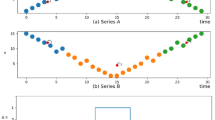Abstract
Anomaly detection is important to learn from major past events and to prepare for future crises. We propose a new anomaly detection method that visualizes multivariate data in a 2- or 3-dimensional space based on the probability of belonging to a mixture component and the probability of not belonging to any components. It helps to visually understand not only the magnitude of anomalies but also the relationships among anomalous and normal samples. This may provide new knowledge in the data, since we can see it from a different viewpoint. We show the validity of the proposed method by using both an artificial and an economic time series.
Similar content being viewed by others
References
H. Akaike (1974) ArticleTitleA new look at the statistical model identification IEEE Transactions on Automatic Control 19 716–723 Occurrence Handle10.1109/TAC.1974.1100705
V. Barnett T. Lewis (1984) Outliers in Statistical Data EditionNumber2 Wiley New York
BrockWell, P. J. and Davis, R. A. (2002) Introduction to Time Series and Forecasting. Springer-Verlag.
C. Chen L. Liu (1993) ArticleTitleJoint estimation of model parameters and outlier effects in time series Journal of the American Statistical Association 88 284–297
Davidson, I. and Ward, M. (2001) A particle visualization framework for clustering and anomaly detection. Proceedings of KDD Workshop on Visual Data Mining.
A. P. Dempster N. M. Laird D. B. Rubin (1977) ArticleTitleMaximum likelihood from incomplete data via the EM algorithm (with discussion) Journal of the Royal Statistical Society, Series B 39 1–38
Fawcett, T. and Provost, F. (1999) Activity monitoring: Noticing interesting changes in behavior. Proceedings of Fifth ACM SIGKDD International Conference on Knowledge Discovery and Data Mining, pp. 53–62.
A. Gorldenberg (2002) ArticleTitleEarly statistical detection of anthrax outbreaks by tracking over-the-counter medication sales Proceedings of the National Academy of Sciences of the United States of America 99 5237–5240 Occurrence Handle10.1073/pnas.042117499 Occurrence Handle11959973
T. Kamada S. Kawai (1989) ArticleTitleAn algorithm for drawing general undirected graphs Information Processing Letters 31 7–15 Occurrence Handle10.1016/0020-0190(89)90102-6
Lutkepohl, H. (1993) Introduction to Multiple Time Series Analysis. Spinger-Verlag.
J. Rissanen (1978) ArticleTitleModeling by shortest data description Automatica 14 465–471 Occurrence Handle10.1016/0005-1098(78)90005-5
M. Rorvig (1999) ArticleTitleImages of similarity: a visual exploration of optimal similarity metrics and scaling properties of TREC document sets Journal of the American Society for Information Science 50 639–651 Occurrence Handle10.1002/(SICI)1097-4571(1999)50:8<639::AID-ASI2>3.0.CO;2-C
S. Sato (2003) ArticleTitleStepwise prediction for economic time series by using vector autoregressive model Science of Modeling, AIC2003, ISM Report on Research and Education 17 225–233
H. Tong KS. Lim (1980) ArticleTitleThreshold autoregression, limit cycles and cyclical data Journal of the Royal Statistical Society, Series B 42 245–292
S. Torgerson (1958) Theory and Methods of Scaling Wiley New York.
A. Weigend M. Mangeas A. Srivastava (1995) ArticleTitleNonlinear gated experts for time series: discovering regimes and avoiding overfitting International Journal of Neural Systems 6 373–399 Occurrence Handle10.1142/S0129065795000251 Occurrence Handle8963468
CS. Wong WK. Li (2000) ArticleTitleOn a mixture auto regressive model Journal of the Royal Statistical Society, Series B 62 95–115
Yamada, T., Saito, K. and Ueda, N. (2003) Cross-entropy directed embedding of network data. ICML2003 832–839.
N. Ye Q. Chen (2001) ArticleTitleAn anomaly detection technique based on a chi-square statistic for detecting intrusions into information systems Quality and Reliability Engineering International 17 105–112 Occurrence Handle10.1002/qre.392
Author information
Authors and Affiliations
Rights and permissions
About this article
Cite this article
Iwata, T., Saito, K. Visualization of Anomalies Using Mixture Models. J Intell Manuf 16, 635–643 (2005). https://doi.org/10.1007/s10845-005-4367-x
Issue Date:
DOI: https://doi.org/10.1007/s10845-005-4367-x




